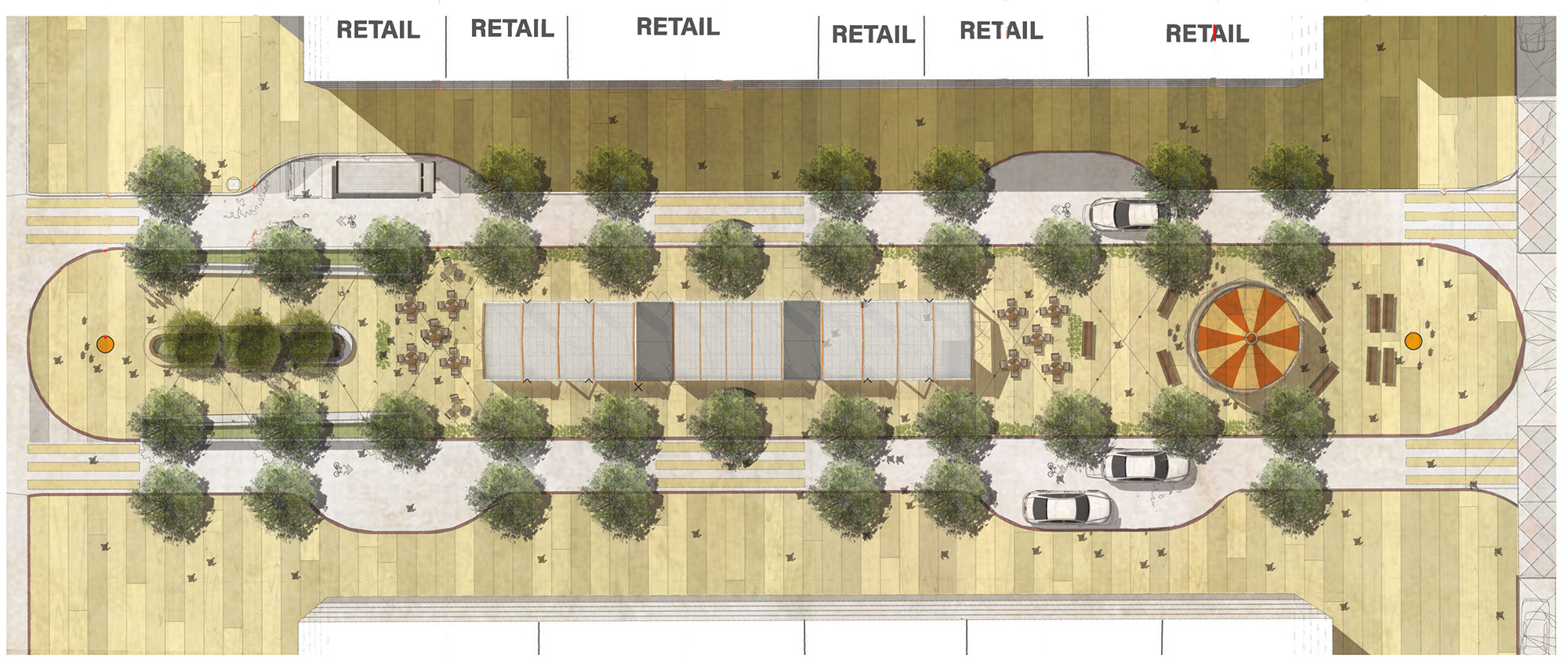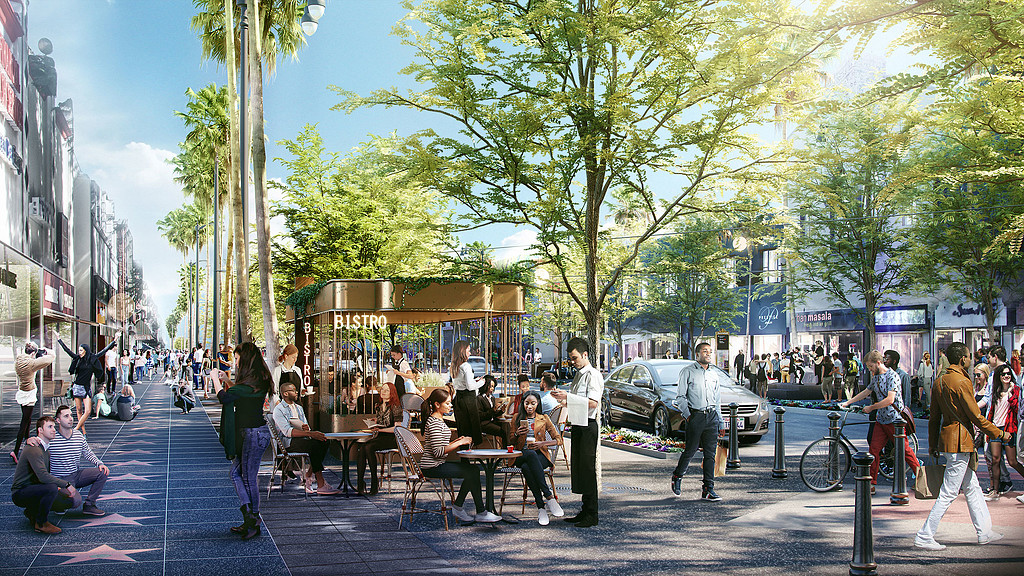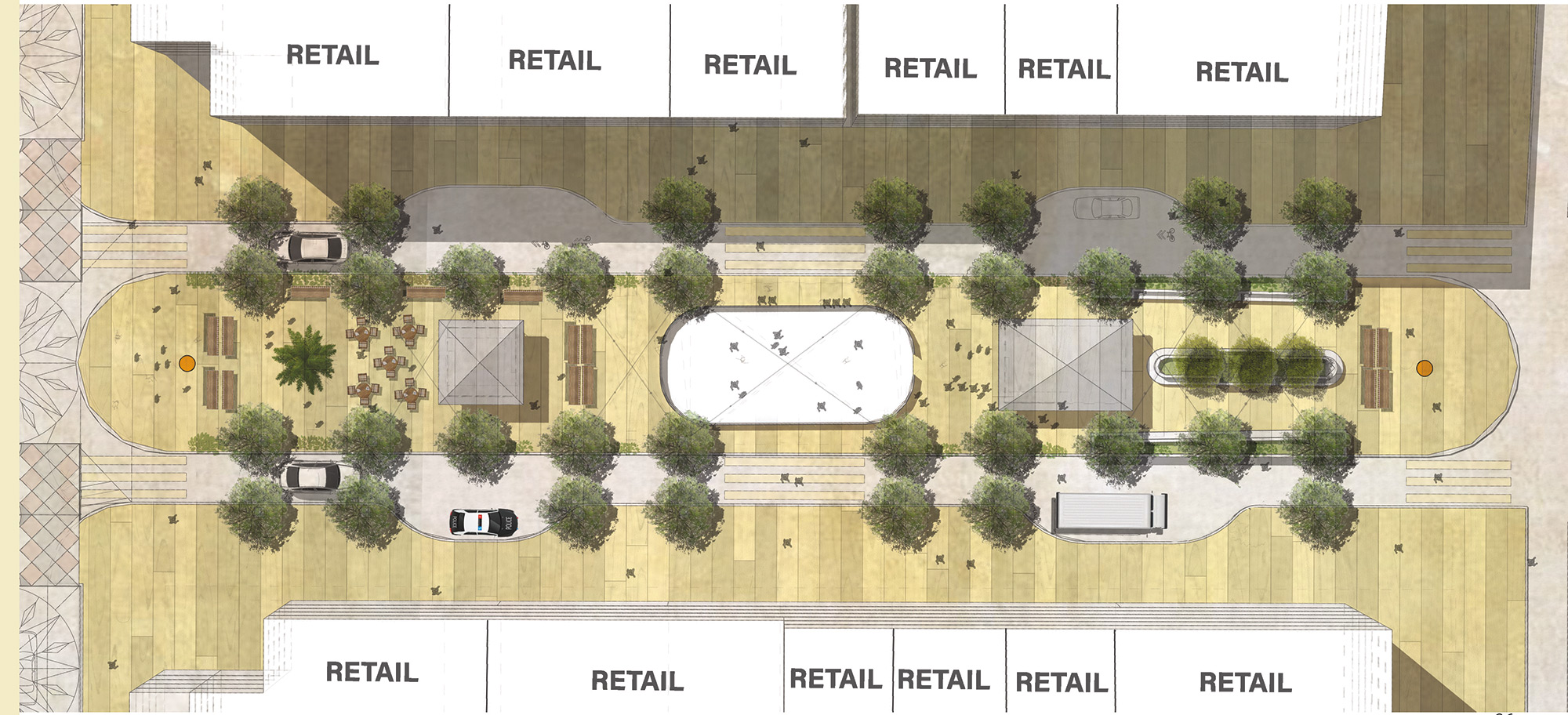Why Investing in Public Space Matters for Cities and Real Estate Developers
February 02, 2021 | By J.T. Theeuwes
For residential and commercial real estate purchases, location is one of the single most important decisions to be made — whether one’s looking for a place to set up a brick-and-mortar restaurant, office space, nail salon, boutique, or personal residence. And right now, perhaps no other location or space type is in higher demand than pedestrian-friendly, outdoor public space. Since the pandemic began, restaurants have converted parking spaces into outdoor dining, cities have opened up street lanes to pedestrians, and public parks and plazas have become places of refuge and respite for those confined to their homes during shelter-in-place orders.
Studies show that locating developments next to well-designed public spaces have positive economic benefits for businesses, residents, and the community as a whole. Evidence has been mounting that people, young and old, want to live and work in walkable communities — places that offer safe, ample, and interesting urban spaces to shop, eat, exercise, socialize, or simply spend time in. Cities need to understand that there are powerful economic reasons to invest in walkability. From public parks, to plazas, to streetscapes and sidewalk spaces, cities and developers should continue to promote the inclusion of walkable, pedestrian-oriented public spaces to create livable, healthy communities.
For Business
For businesses, how close you locate to your competitor and the demographics of the area are important. But equally imperative for in-person sales is the need to draw people into a store. And one of the easiest ways to accomplish this is to be visible to as many people passing by your storefront as possible. The simple and time-honored formula is having more people in front of your store and having those people spend more time there equals a greater opportunity to engage in a transaction. A more welcoming pedestrian environment can draw people in, and in doing so, boost business.
Whenever a street is redesigned to prioritize walking, biking, or transit, typically at the expense of single-occupancy motor vehicles, business owners sometimes object on grounds that it will lead to a reduction in business opportunity due to the reduction of cars. But this opposition is often unfounded, as business owners can misjudge the travel habits of their customers. A Vancouver study concerning new protected bike lanes through downtown found that retailers thought 40% of their customers drove to their stores, while customer intercept surveys determined that the number was closer to 20%. Twice as many customers cycled to the stores as business believed, and while merchants guessed that 25% of customers rode transit, 42% actually did.
Once implemented, streetscape redesigns have a proven record of increasing pedestrian traffic and helping businesses. Many people thought the pedestrianization of New York’s Times Square would prove detrimental to the businesses in the area. But 10 years since the project was implemented, the area has seen a jump in pedestrian traffic by over 100,000 people per day — from 356,000 in 2008 to 466,000 in 2018. These people have been safer, with a 35% reduction in accidents between pedestrians and vehicles, and have enjoyed greater shopping due to the attractiveness of commercial opportunities.
A healthy and vibrant streetscape’s contribution to the economic health of a business is sometimes difficult to quantify, but more and better data is becoming available. A 2013 study from the New York City Department of Transportation (NYC DOT) used sales tax receipts to compare retail activity before several NYC street redesigns, including road diets, plazas, protected bike lanes, and select bus service routes were implemented and after they were completed. The results were then compared to similar nearby streets where no design changes were implemented. Using tax data from the Department of Finance, NYC DOT found a 49% increase in retail sales (versus a 3% overall increase for all of Manhattan) and a 49% drop in commercial vacancies around areas where the city created new pedestrian plazas and bike lanes from 2007 to 2012.
According to the study, the results “provided convincing evidence that improved accessibility and a more welcoming street environment created by the projects generated increases in retail sales in the project areas.” The study suggests that using retail sales data allows for a rigorous metric to assist government agencies, as well as give community members the ability to measure the effects of such projects and “address the concerns of local residents and business owners about potential project impacts, replacing anecdote or personal experience with comprehensive data.”
For Residents
In Jeff Speck’s 2018 book, “Walkable City Rules,” he provides support to bolster the argument for cities to invest in walkability for residents, including statistics such as: 64% of millennials first choose where they want to live, and only then do they look for work; 77% say they plan to live in an urban core; and 63% of millennials (and 42% of baby boomers) want to live in a place where they don’t need a car. Speck concludes that, “Companies and cities that wish to attract young talent need to provide the walkable urban lifestyle [these constituencies] desire.”
Walk Score promotes walkable neighborhoods by rating 2,800 cities and 10,000 neighborhoods in the U.S. and Canada on a scale of 1 to 100 on the basis of walking access to a number of different types of amenities. Each point of Walk Score has been shown to be worth $3,000 in a typical metro area and a 10 point increase in Walk Score increases commercial property values by 5-8%. As noted by Speck, “home values determine local property tax revenue, justifying investments in walkability.”
For Community
It is paramount that any new plaza, park, or urban streetscape design is the product of the people who live, work, and make up the community. But it is equally critical to educate and bring to the table the necessary information, data, and expertise for these constituencies to make informed decisions.
Discourse Media, a community-powered news media company in Vancouver, has attempted to determine the full cost and benefit of different types of mobility options through the urban realm: driving, taking the bus, cycling, and walking in Metro Vancouver. Their Cost of Commute Calculator takes into account costs to build roads and associated infrastructure, but they also consider costs to society through less obvious impacts such as emissions, climate change, accidents, congestion, and noise pollution. While imperfect, the Cost of Commute Calculator is an informative way to remember that all transportation methods that comprise the urban realm of our cities are in some way subsidized by society — single occupancy vehicles most of all and that the costs of public health care should also be considered in the cost/benefit equation.
Our urban streetscape projects are instilled with the needs and desires of the social groups they serve. Here are several ideas city planners can keep in mind when installing streetscapes to promote positive economic benefits to the community:
Adding amenities and programmed activities to outdoor urban spaces brings people to these places. As noted, attracting more people for a greater amount of time increases the opportunity to engage in commerce. For the Tsuut’ina First Nation outside Calgary, we provided a center median wide enough along a future stretch of retail and mixed-use buildings to accommodate various amenities appropriate for the climate and culture. A children’s splash fountain converts to a small ice rink in winter while a glass-walled wine bar named “The Greenhouse” glows like a lantern at night, illuminating the streetscape and providing an amenity destination. These spaces are flanked with areas for holiday tree lighting, playful public art, and other amenities such as an outdoor merry-go-round — all giving reasons for shopping trips to turn into longer outings and lasting memories.


Giving people more options to move through an urban streetscape beyond the single occupancy vehicle makes for better economics, since, as previously noted in the Vancouver study , increased pedestrian and bike traffic can boost sales for street-facing businesses. For the Hollywood Walk of Fame master plan, we have provided more space for people by changing the existing ratio of pedestrianized space from 30% of the right-of-way to 70% by widening sidewalks and adding a protected micro-mobility lane for bicycles, scooters, and other people-powered wheeled transport. Curb bulbs reduce the distances pedestrians travel to cross vehicular paths and crosswalks and intersections are raised to the level of the sidewalk to allow pedestrians to be more visible to motorists and to give them priority.
Providing communities with well-designed, pedestrian-oriented urban plazas and streetscapes delivers a rich variety of positive economic benefits in addition to promoting happier and healthier lifestyles. Now more than ever, these outdoor urban experiences and provisions will be needed to increase the economic and health resiliency of city life.
For media inquiries, email .


